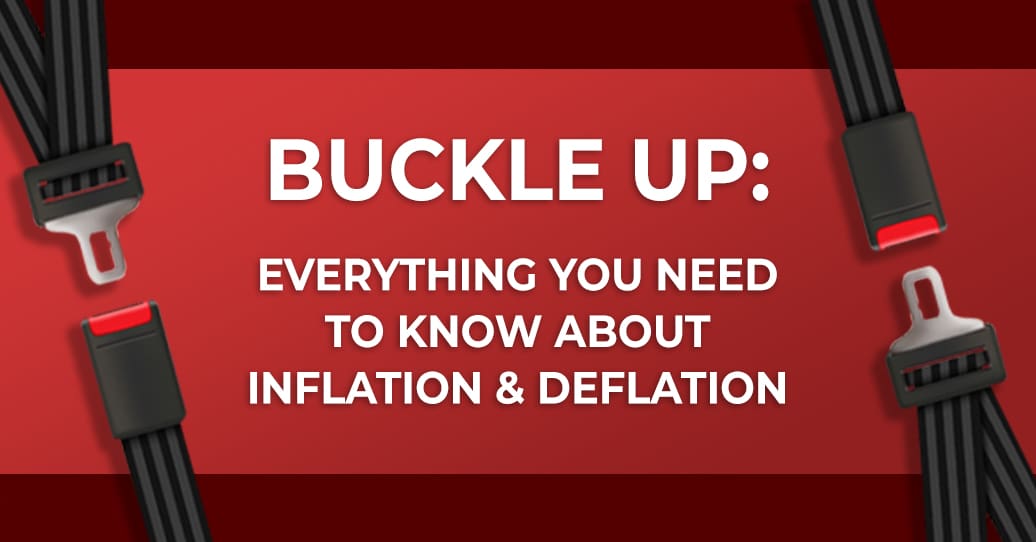Picture this: You’re cruising down the economic highway when suddenly, a sign declares, “INFLATION ZONE AHEAD!”
Then, as you tug on your seat belt to confirm it’s secure, another sign says, “DEFLATION DANGER – PREPARE FOR PLUNGE!”
You’re worried, cautious, and mostly, you’re as confused as you were in driver’s ed class when they tried to explain how you should react when your car begins to skid.
The headlines are buzzing about inflation and deflation, but it’s important to remember that both are natural parts of the economic cycle.
Whether you’re a business owner, retired, or just starting out, understanding inflation and deflation is crucial for making well-informed decisions to protect your finances and keep your portfolio on track.
Before you flip on your GPS or ask Siri for deflation directions, let’s review what these terms mean and how they should be navigated.
And stick around until the end for some inflation trivia!
- What is inflation? Imagine a world where your morning coffee costs $10. That’s inflation – a sustained increase in the price level of goods and services. It’s like your money shrinking in value with each passing day. While mild inflation (around 2% annually) can be healthy for an economy, rising inflation erodes your purchasing power and may lead to economic instability.
- What about deflation? So, if inflation is bad (prices rising), then deflation must be good, right? Well, not so fast. In a deflationary environment, businesses can struggle to sell goods at higher prices, leading to reduced production and layoffs. Consumers delay purchases, hoping prices will fall, which further suppresses demand. This lack of economic activity can be even more damaging than inflation.
So, what should you do?
Inflation
If you’re a business owner… Diversify asset classes, monitor your investments regularly, and adjust your allocations depending on inflation levels and economic trends. Look for ways to reduce expenses within your business, streamline operations, cut costs, and even renegotiate contracts with suppliers.
If you’re a retiree… Review your asset allocation to ensure a proper mix of stocks, bonds, and inflation protected assets. Spread your investments across sectors and industries to minimize risk from specific market downturns. Maintain a long-term perspective and commit to following your financial plan.
If you’re a young professional… Prioritize long-term growth assets like stocks and bonds and ensure a mix of asset classes. Also be sure to contribute to your retirement accounts, pay down debt, and build an emergency fund.
Deflation
If you’re a business owner… Prioritize income-generating investments and focus on assets that provide consistent income, like dividend-paying stocks or rental properties. This will help cushion the blow of falling wages or salary cuts.
If you’re a retiree… Stay flexible. Deflationary environments can be unpredictable. Be prepared to adjust your investment strategy and spending habits as the situation evolves. Don’t delay essential purchases. While waiting for prices to fall might seem tempting, essential needs shouldn’t be put on hold.
If you’re a young professional… Focus on long-term growth and build a resilient financial foundation so you can ultimately benefit in the long run.
Remember, we’re here to help you work through the concepts above together. Simply click reply to this email and we can find time to talk about how this environment may be impacting you, your family, and your business.
Trivia
What common household item has historically been used as a barometer for inflation?
The answer: A loaf of bread.
Bread has been a staple food for centuries, and its price has often been closely tied to economic conditions and inflation. When inflation rises, the cost of grain and other ingredients increases, leading to higher bread prices. Conversely, during periods of deflation, bread prices might go down, making it a more affordable option for households.
The term “bread and butter issue” even stems from the importance of bread as a basic necessity, reflecting its historical significance as a gauge of economic well-being.

